Revolutionising LED Lighting: Paper Published in IEEE Transactions on Industry Applications
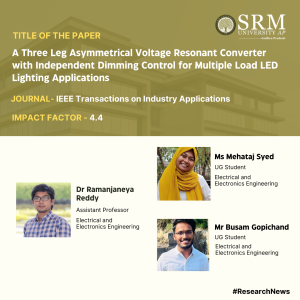 In a significant academic accomplishment, Dr Ramanjaneya Reddy, Assistant Professor in the Department of Electrical and Electronics Engineering, along with UG students Ms Mehataj Syed and Mr Busam Gopichand, have recently published a groundbreaking paper titled “A Three Leg Asymmetrical Voltage Resonant Converter with Independent Dimming Control for Multiple Load LED Lighting Applications” in the esteemed Q1 journal IEEE Transactions on Industry Applications. The journal boasts an impressive impact factor of 4.4, further underscoring the importance of this research contribution.
In a significant academic accomplishment, Dr Ramanjaneya Reddy, Assistant Professor in the Department of Electrical and Electronics Engineering, along with UG students Ms Mehataj Syed and Mr Busam Gopichand, have recently published a groundbreaking paper titled “A Three Leg Asymmetrical Voltage Resonant Converter with Independent Dimming Control for Multiple Load LED Lighting Applications” in the esteemed Q1 journal IEEE Transactions on Industry Applications. The journal boasts an impressive impact factor of 4.4, further underscoring the importance of this research contribution.
The paper delves into the development of a novel Three Leg Asymmetrical Voltage Resonant Converter that offers independent dimming control for multiple load LED lighting applications. This innovation holds great promise for enhancing the efficiency and versatility of LED lighting systems, paving the way for more sustainable and adaptable lighting solutions in various industrial applications.
Dr Ramanjaneya Reddy’s leadership and the collaborative efforts of Ms Mehataj Syed and Mr Busam Gopichand have culminated in this significant publication, which not only adds to the body of knowledge in the field but also showcases the talent and dedication of the researchers at the department.
This achievement highlights the commitment to excellence and innovation within the Department of Electrical and Electronics Engineering, positioning it as a hub for cutting-edge research and academic prowess. The impact of this research is expected to reverberate across the industry, contributing to advancements in LED lighting technology and its applications.
The publication of this paper underscores the quality and rigour of the research solidifying their reputation as leaders in the field. This accomplishment is a testament to the department’s commitment to pushing boundaries and making meaningful contributions to the field of electrical engineering.
Congratulations to Dr Ramanjaneya Reddy, Ms Mehataj Syed, and Mr Busam Gopichand on this remarkable achievement, and we look forward to seeing the continued impact of their research in the field.
Abstract
This work proposes a three-leg asymmetrical voltage resonant converter for multiple load Light Emitting Diode (LED) lighting applications. The proposed converter is developed with a common leg-1 for both load-1 and load-2. The load-1 is powered from asymmetrical voltage between leg-1 and leg-2. Similarly, load-2 is powered from asymmetrical voltage between leg-1 and leg-3. The proposed circuit provides the following major contributions: (1) Independent dimming control of LED loads; (2) Zero Voltage Switching (ZVS) of all power switches; (3) High efficiency; and (4) Asymmetrical voltage regulation. To achieve independent dimming control, the voltages between legs are made zero by dimming leg-2 and leg-3 independently. Two resonant circuits are connected in the proposed circuit. Owing to this all the power switches operate with ZVS, which reduces the switching losses. Further, two LED lamps are connected in series with battery sources to supply the threshold voltage to lamps which in turn results in a lower power processing of the converter.
Explanation of Research in Layperson’s Terms
This work proposes a three-leg asymmetrical voltage resonant converter with independent dimming control for multiple load LED lighting applications. The proposed converter drives multiple loads independently with a dimming feature. The converter is developed with leg-1 is common for both LED loads. The major contributions of the proposed LED driver are independent dimming control, asymmetrical voltage regulation, zero voltage switching of all the power switches, and high efficiency. The threshold voltage of LED loads is supplied by batteries connected in series with LED loads, which will help in lower power processing of the proposed converter. Further, due to soft switching technology implemented in this converter, it reduces the losses in the system considerably increasing efficiency.
Title of Research Paper in the Citation Format
A Three Leg Asymmetrical Voltage Resonant Converter with Independent Dimming Control for Multiple Load LED Lighting Applications.
Citation: Ramanjaneya Reddy Udumula, et. al, “A Three Leg Asymmetrical Voltage Resonant Converter with Independent Dimming Control for Multiple Load LED Lighting Applications,” IEEE Transactions on Industry Applications, Feb 2024. doi: 10.1109/TIA.2024.3363676
Practical and Social Implementation of Research
To achieve effective and efficient use of energy resources under the sustainable development goals, Light Emitting Diodes (LEDs) have emerged as a global lighting industry solution. Over the conventional lighting sources such as incandescent lamps, fluorescent lamps, and high intensity discharge lamps, LEDs are i) more efficient, ii) eco-friendly due to absence of toxic gases, iii) have longer life span up to one lakh year, iv) high luminous intensity and v) good colour rendering index. LED’s requires low voltage direct current supply and the V-I characteristics of LEDs which is like Shockley diode represents the exponential growth of current over a small voltage variation which may damage the LED or effects the illumination. Hence, an LED driver is necessary in an LED system to supply LEDs with constant current. DC fed LED drivers are more reliable due to absence of AC-DC conversion stage and power factor correction stage which are crucial in AC fed LED drivers. Therefore, DC fed LED drivers are paid more attention in recent times in the majority of battery-powered/solar-powered applications. Given its features of high power, exceptional efficiency, cost-effectiveness, and flicker-free operation, this innovation is well-suited for streetlight/stadium lighting applications.
Collaborations
Dr. Kasi Ramakrishna Reddy, Assistant Professor
Department of Electrical and Electronics Engineering, Vasavi College of Engineering, Hyderabad
Future Research Plans
The future work is on PV/battery fed LED driver topologies suitable for streetlighting/stadium lighting applications with low component count, high efficiency, reduced device stress, and flicker free lighting system
- Published in Departmental News, EEE NEWS, News, Research News
Advances in Electric Vehicle Technology: A Study on Bi-Directional Converters
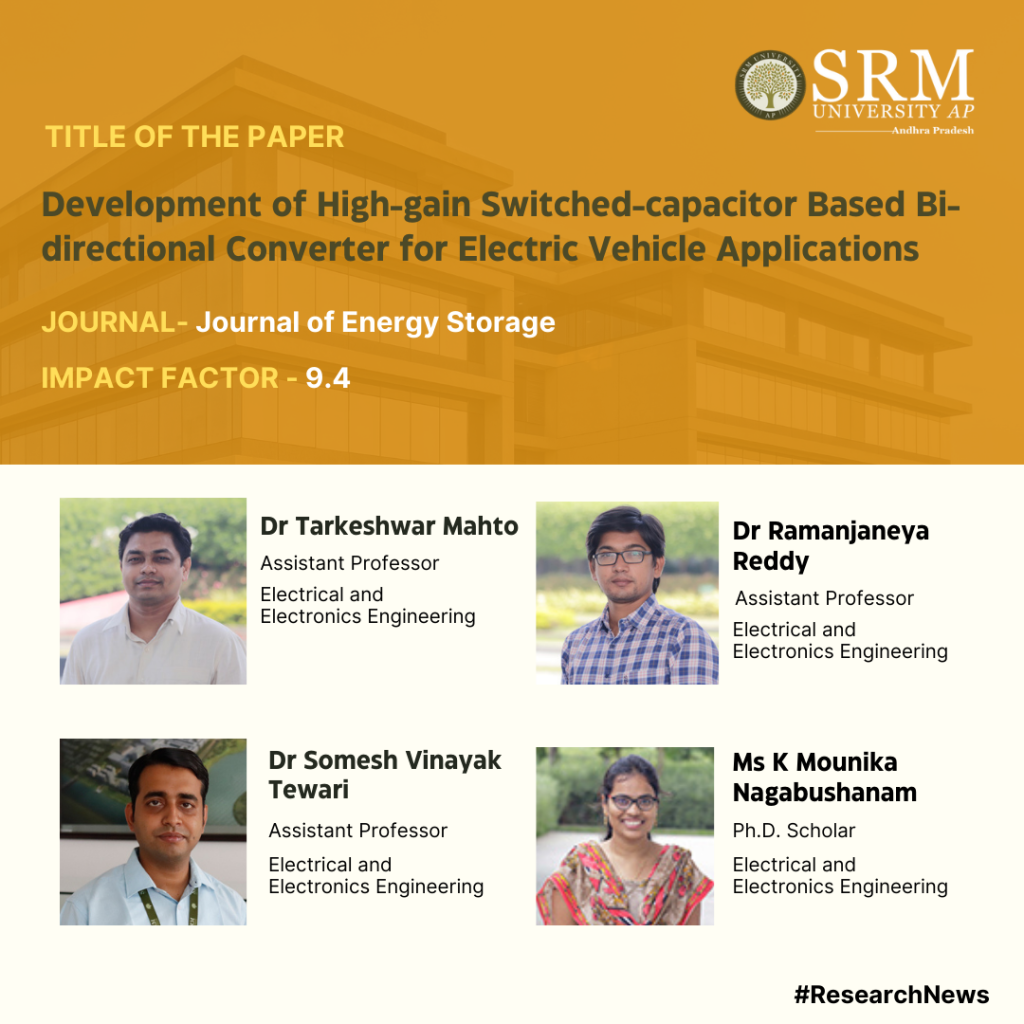
Electric Vehicles are in vogue today, thanks to the heightened environmental concerns, greater availability of models, increased cost competitiveness and improved vehicle ranges. To contribute to the growing field of electric vehicle technology, Assistant Professors, Dr Tarkeshwar Mahto, Dr Somesh Vinayak Tewari and Dr Ramanjaneya Reddy from the Department of Electrical and Electronics Engineering at SRM University-AP along with the research scholar, Ms K Mounika Nagabushanam, conducted a study and published a research paper titled “Development of High-Gain Switched-Capacitor Based Bi-Directional Converter for Electric Vehicle Applications.” The team’s research focuses on creating a bi-directional DC-DC converter that enables power flow from the battery to the motor and vice versa while maintaining necessary voltage gains and ensuring improved efficiency and low cost.
Abstract
High efficiency, high voltage transfer ratio (VTR), and low input ripple current are required in any bidirectional DC-DC converter (BDC) that plays a major role in interfacing batteries in applications like DC microgrids and electric vehicles (EVs). To meet these requirements, a switched capacitor-based BDC is proposed to interface the battery with a propulsion system via a DC Link. It has a simple circuit with only a set of switching operations, High VTR, and lesser ripple current on the low voltage (LV) side, which are advantages of the proposed High Gain Switched-Capacitor Bi-directional DC-DC Converter (SC-BDC), making it appropriate for use in EVs. The steady-state analysis, design consideration of passive components, loss and efficiency analysis are presented. Finally, the proposed High Gain SC-BDC is compared with a few of the existing BDCs in the literature. The feasibility of the converter was demonstrated by simulating a 200 W converter and validating results produced in a MATLAB environment.
Practical implementation of your research or the social implications associated with it.
The developed converter can be used in Electric Vehicle for integration of battery to traction motor.
Collaborations.
1. Majed A. Alotaibi, Department of Electrical Engineering, College of Engineering, King Saud University, 11421, Saudi Arabia.
2. Hasmat Malik, Department of Electrical Power Engineering, Faculty of Electrical Engineering, University Technology Malaysia (UTM), Johor Bahru 81310, Malaysia.
3. Fausto Pedro García Márquez, Ingenium Research Group, Universidad Castilla-La Mancha, 13071 Ciudad Real, Spain.
As part of their future research plans the team plans of working on noise reduction methods that are brought on by regeneration action and to incorporate various control techniques to keep the DC link voltage of the propulsion system constant.
We wish the team all success in their future endevours!
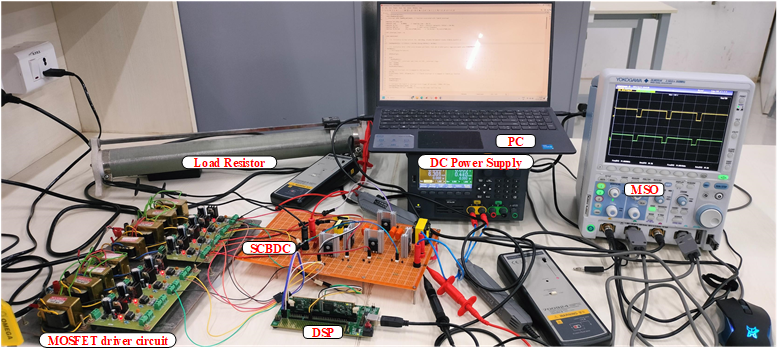
- Published in Departmental News, EEE NEWS, News, Research News
Unveiling Literary Insights on Salman Rushdie’s The Moor’s Last Sigh
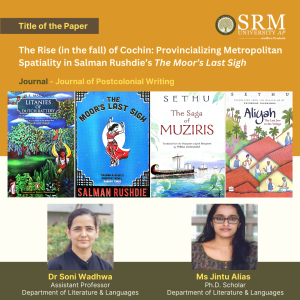 In a remarkable achievement, Dr Soni Wadhwa, Assistant Professor in the Department of Literature and Languages at SRM University-AP, and Ms Jintu Alias, a PhD Scholar, have made a significant contribution to the field of postcolonial studies with their paper titled “The rise (in the fall) of Cochin: Provincializing metropolitan spatiality in Salman Rushdie’s The Moor’s Last Sigh.”
In a remarkable achievement, Dr Soni Wadhwa, Assistant Professor in the Department of Literature and Languages at SRM University-AP, and Ms Jintu Alias, a PhD Scholar, have made a significant contribution to the field of postcolonial studies with their paper titled “The rise (in the fall) of Cochin: Provincializing metropolitan spatiality in Salman Rushdie’s The Moor’s Last Sigh.”
The paper, published in the highly esteemed Journal of Postcolonial Writing offering a fresh perspective on Salman Rushdie’s acclaimed novel, “The Moor’s Last Sigh.” Through their insightful analysis, Dr Wadhwa and Alias challenge the conventional notions of metropolitan spatiality and provide a nuanced understanding of the provincial city of Cochin.
Dr Soni Wadhwa and Jintu Alias, a promising PhD Scholar, have meticulously analysed Rushdie’s The Moor’s Last Sigh, shedding light on the complex dynamics of metropolitan spatiality and the rise and fall of Cochin within the narrative.
Their research explores Rushdie’s portrayal of Cochin, challenging traditional notions of metropolitan spaces and offering a fresh perspective on the provincial nation of such spatialities. This groundbreaking analysis delves deep into the layers of cultural, historical, and socio-political contexts within Rushdie’s work, showcasing the authors’ keen insights and critical thinking.
The publication of this paper highlights the invaluable contributions of our faculty and scholars in the field of literature and postcolonial studies. It is a testament to the rigorous academic environment and the commitment to excellence fostered at SRM University-AP.
We extend our warmest congratulations to Dr Soni Wadhwa and Jintu Alias for their remarkable achievement. Their dedication to research and passion for exploring the nuances of literature continue to inspire us all.
Explanation of the Research in Layperson’s Terms
Bombay/Mumbai is a great city widely celebrated in literature, especially for its cosmopolitanism. Salman Rushdie’s novel The Moor’s Last Sigh has been read by various critics for the richness of the portrayal of Mumbai. In their research, PhD scholar Jintu Alias and her PhD supervisor Dr Soni Wadhwa have analysed the representation of Cochin in the novel. Regarding their research they say, “For very long, Cochin’s presence has been eclipsed by that of Mumbai. But there is more to the novel than Bombay’s history. Like any art or literature, this novel is open to multiple interpretations. Our study is focused on the depiction of space in postcolonial literature with a focus on the island city Cochin in Kerala. When we immersed ourselves into the novel, we found that its charm is irresistible. Rushdie primarily opened a new city for other writers to explore. This novel was followed by several more novels that took an even closer look at the history of Cochin (now Kochi).”
Abstract
Indian fiction and critical engagements with it have a metropolitan bias. The preference for representations of big cities such as Mumbai in fiction means that non-metropolitan (“provincial”) spaces in India face neglect, literary and otherwise. This article argues for provincialising Indian fiction by exploring non-metropolitan locations as imagined in works of fiction to unpack alternative spatiality. The example offered is Salman Rushdie’s The Moor’s Last Sigh. In most readings of the novel, Bombay (along with Moorish Spain) is highlighted as a metropolitan model for India. Cochin does not figure in these readings, which are passed over as if just a random background or setting for the characters to be launched into Mumbai. This article addresses Cochin’s marginalisation by investigating how the island city offers a provincial, alternative, non-metropolitan theorisation of spatialities in Indian fiction. The larger objective is to make space for similarly marginalised non-European locales in the discourse of cosmopolitanism.
Social Implications
- We hope that with this interpretation of the novel from the point of view of Cochin and its history and cosmopolitanism, smaller cities in India get more attention from literary critics.
- We also hope that our research excites further studies and creative writing on other aspects of cultural traditions practised in smaller cities in India. There are many more themes and historical and geographical settings to explore in Indian literature!
Future Research
In continuation of our method of reading different Kochi texts, we will engage with more novels in the future. Our previous reading of another Kochi novel was published in Modern Jewish Studies in September 2023. We look forward to strengthening this body of work in the future.
About This Collaboration
PhD scholar Ms Jintu Alias and Assistant Professor Dr Soni Wadhwa have been working on this area of the Kochi novel since May 2021. This has been an exciting spatiality project in the context of Indian literature.
Citation
Alias, J., & Wadhwa, S. (2024). The rise (in the fall) of Cochin: Provincializing metropolitan spatiality in Salman Rushdie’s The Moor’s Last Sigh. Journal of Postcolonial Writing, 1-13. https://doi.org/10.1080/17449855.2024.2307408
- Published in Departmental News, English Current Happenings, News, Research News
A Pathbreaking Cross Between Medicine and Technology
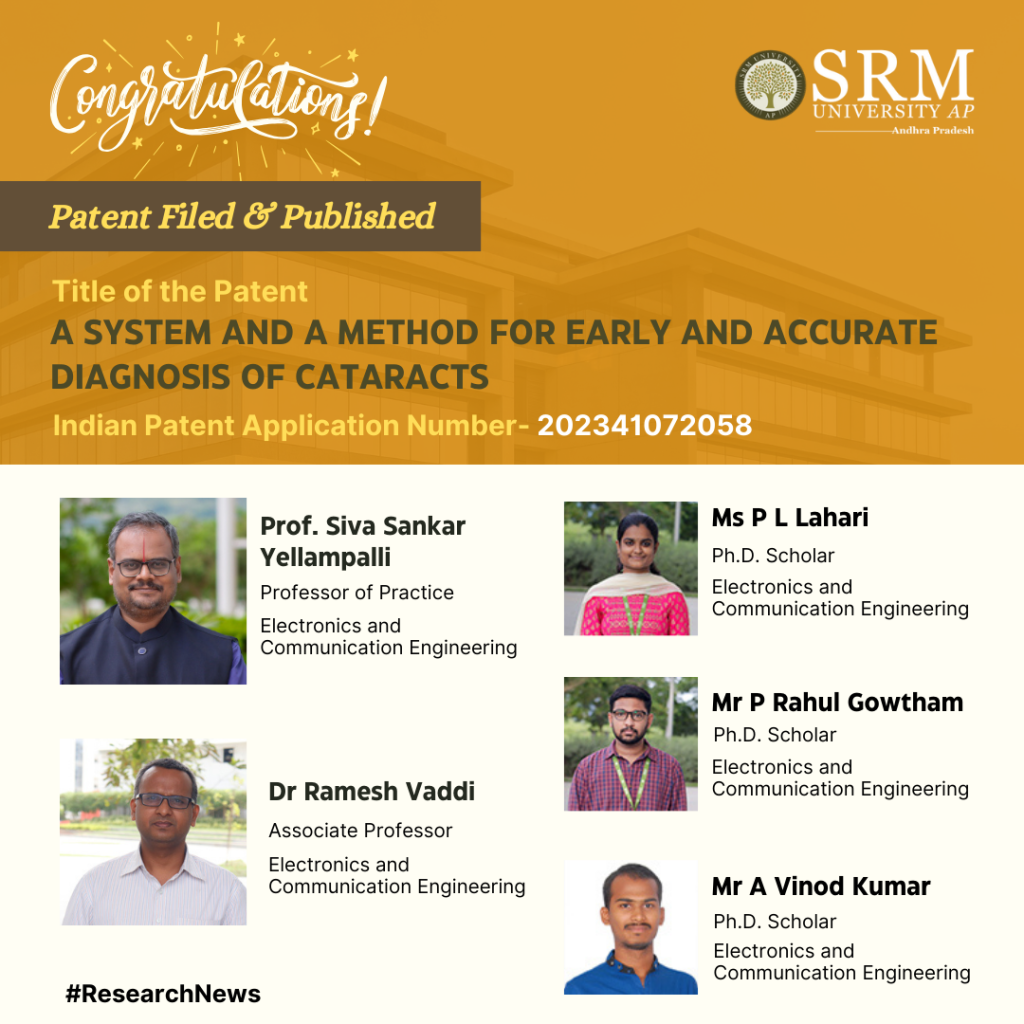
The advent of scientific research and technologies in the domain of medicine has recently taken limelight due to its immense benefit on humankind and the medical community. The expert faculty and scholars have recently published a patent, “A System and a Method for Early and Accurate Diagnosis of Cataracts” with Application no.: 202341072058 has put forth an engaging invention on utilising technology for early cataract recognition. Hearty congratulations to Prof. Siva Sankar Yellampalli, Professor, Dr Ramesh Vaddi, Associate Professor, and their Ph.D. Scholars Ms P L Lahari, Mr P Rahul Gowtham, and Mr A Vinod Kumar from the Department of Electronics and Communication Engineering for this groundbreaking achievement!
Abstract
Cataracts are a common eye condition in which the lens of the eye gets clouded, impairing vision. Early cataract detection is crucial for prompt treatment and vision preservation. We have classification and prediction algorithms like VGG, ResNet, DenseNet, Xception, Inception, and other object detection techniques like Yolo, Fast R-CNN, and SSD. Various pre-trained models are employed for cataract categorisation and prediction. Several attempts to detect cataracts have been made, but none have proven effective. A clinical examination by eye specialists is used to diagnose cataracts. An edge board can be used instead of a clinical examination to diagnose cataracts.
We created a method for real-time cataract recognition using the present pre-trained weights of the object detection model YoLoV5. We employ pre-trained YoLo V5 weights for model training, testing, and validation. Connect the Jetson Nano board and Lenovo HD USB camera to the CPU, which serves as the CPU. The monitor is used for programming, and the output is presented on the monitor owing to the board communicating with the camera. The result shows the image with an eye labelling box that tells if the eye is normal or cataract.
- Published in Departmental News, ECE NEWS, News, Research News
Advocating for Change: Shedding Light on the Struggle of Acid Attack Survivors
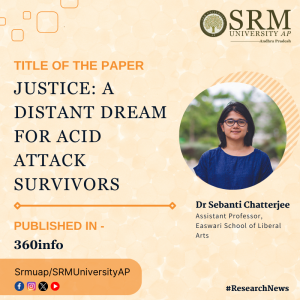 In a thought-provoking paper titled “Justice A Distant Dream for Acid Attack Survivors,” published in 360 Info, Dr Sebanti Chatterjee, Assistant Professor in the Department of Liberal Arts, delves deep into the persistent challenges faced by acid attack survivors.
In a thought-provoking paper titled “Justice A Distant Dream for Acid Attack Survivors,” published in 360 Info, Dr Sebanti Chatterjee, Assistant Professor in the Department of Liberal Arts, delves deep into the persistent challenges faced by acid attack survivors.
Despite the existence of legal provisions aimed at addressing gender-based violence, the harrowing reality is that acid attacks continue to be a stark and under-addressed form of violence. Dr Chatterjee’s paper sheds light on this critical issue, highlighting the urgent need for greater awareness, support, and legal reform to provide justice and support for survivors.
Through her research, she underscores the importance of recognising and prioritising the plight of acid attack survivors, urging for collective action to create meaningful change. As advocates for social justice, it is imperative that we amplify their voices and work towards a future where justice is not a distant dream but a tangible reality for all survivors.
Abstract
Acid attacks can occur in private or public. These attacks are often rooted in ‘jilted lover’ syndrome or as a manifestation of continued domestic violence. Few cases offer a different narrative: one woman was attacked to teach her father a lesson about property disputes. Ultimately, the acid attack is yet another demonstration of patriarchy’s brutishness.
My (unpublished) research in 2021 with acid attack survivors (including Rima), lawyers, police and other stakeholders in West Bengal — as part of a collaboration between National Human Rights Commission and National Law School of India University, Bangalore — found that despite these various legal advances, acid attack as a form of violence is not prioritised as an issue needing immediate attention, unlike rape and child trafficking.
DOI: 10.54377/e719-077c
Future Research Plan
To explore how a state cultural heritage status makes us explore the social life of an instrument- it’s secular and sacred manifestations, questions of labour, gender and the sustainability model pertinent to its musical and material interpretations.
Topic of research
Soulful beats: Ecology, Labour and Aesthetics of Ghumott
- Published in Departmental News, Liberal Arts News, News, Research News
Pioneering the Future: Ultrafine MgAl2O4 Particle-Stabilised Mg-3Ca Alloy Foams
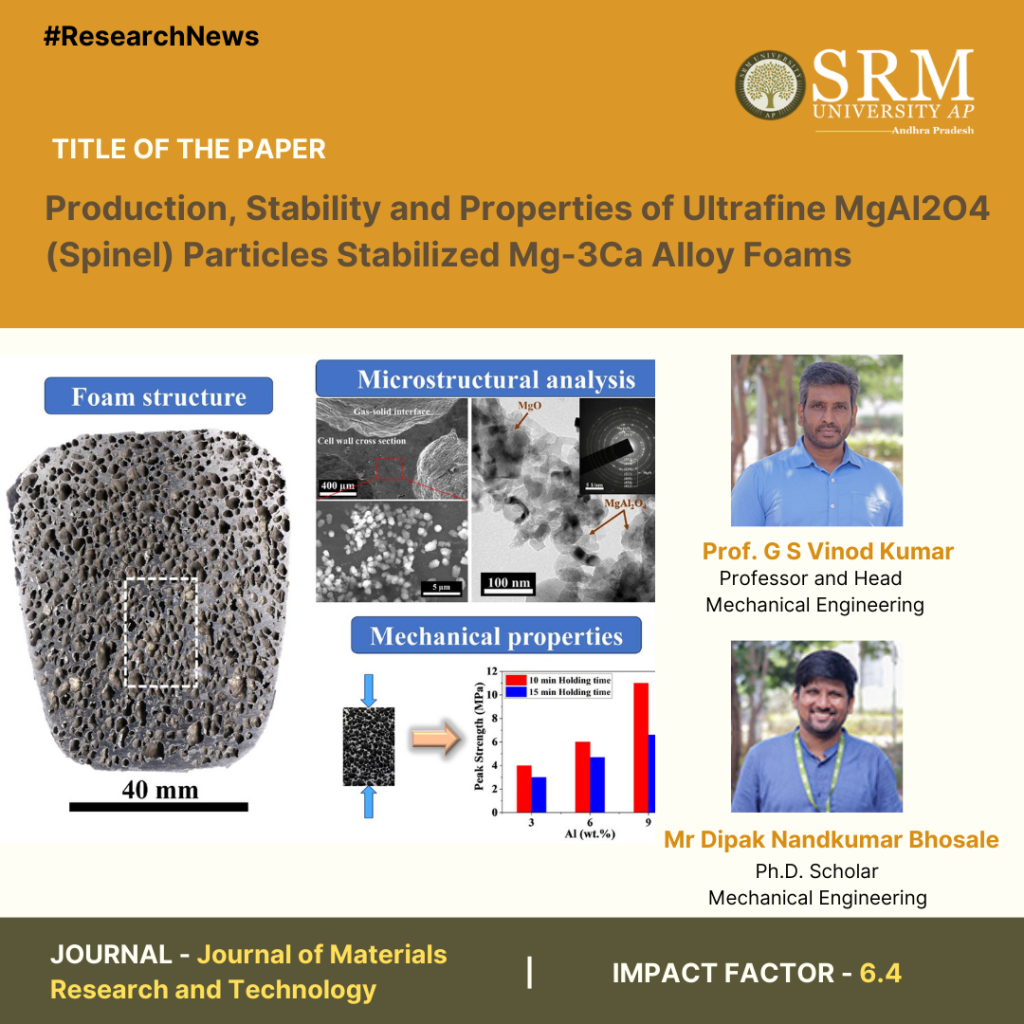
The Department of Mechanical Engineering is thrilled to announce a significant breakthrough in materials science has been achieved through the diligent research efforts of Prof. G S Vinod Kumar, Professor and Head of the Department and his Ph.D. scholar, Mr Dipak Bhosale in their latest paper, “Production, stability and properties of ultrafine MgAl2O4 (Spinel) particles stabilized Mg-3Ca alloy foams”. The study focuses on the development and detailed analysis of Mg–3Ca alloy foams, uniquely enhanced by ultrafine MgAl2O4 (spinel) particles. This innovative research outlines a novel methodology for improving the mechanical properties of magnesium foams, providing unparalleled advantages for a multitude of industrial applications.
Abstract
The present work reports the synthesis and mechanical behaviour studies of Mg–3Ca alloy foams stabilized by ultrafine MgAl 2 O 4 (spinel) particles. The MgAl 2 O 4 particles were created in-situ in the Mg–3Ca alloy melt through the reaction of Mg, Al and O. Foaming was done by adding dolomite (CaMg(CO 3 ) 2 ) as a blowing agent in the melt. The foaming behaviour was studied for different MgAl 2 O 4 content in Mg–3Ca and holding times (10 and 15 min). The study reveals that the presence of MgAl 2 O 4 significantly influences the foaming behaviour of Mg–3Ca alloy resulting in equiaxed cell structure, uniform cell size distribution, and higher expansion in comparison to the Mg–3Ca alloy foam, which contains only MgO and CaO. An in-depth phase and microstructural analysis were performed to investigate the particles present in the gas-solid interface of the foam that contribute to foam stabilization. The quasi-static compression studies of foams exhibited better compressive strength (≈3–11 MPa) and energy absorption capacity (≈1.3–5.7 MJ/m3) in comparison to the Mg foams reported in the literature. The ductility of the Mg foams was also measured and compared with that of existing aluminium foams.

Research Highlights:-
- Innovative Synthesis: The MgAl2O4 particles are synthesized in situ within the Mg–3Ca alloy melt via a controlled reaction involving Mg, Al, and O. This process ensures the uniform dispersion of spinel particles, which is critical for the foam’s structural integrity and performance.
- Foaming Process: By employing dolomite (CaMg(CO3)2) as a blowing agent, the research team meticulously explored the foaming behaviour under various MgAl2O4 contents and holding times (10 and 15 min). The findings highlight a marked improvement in foam expansion and stability.
- Structural and Mechanical Analysis: Through comprehensive phase and microstructural analyses, the pivotal role of MgAl2O4 particles at the gas-solid interface in stabilizing the foam structure was uncovered. Quasi-static compression tests revealed outstanding compressive strength (≈3–11 MPa) and energy absorption capacity (≈1.3–5.7 MJ/m3), surpassing existing benchmarks for magnesium foams.
Key Properties and Applications:-
- Low Density & High Strength-to-Weight Ratio: The Mg–3Ca alloy foams showcase an optimal balance of low density and high mechanical strength, rendering them ideal for lightweight structural applications.
- Enhanced Energy Absorption: Their unique cellular structure provides superior energy absorption capabilities, suitable for impact and crash-resistant applications.
- Biocompatibility: Owing to magnesium’s biocompatibility, these foams are highly promising for biomedical applications, including bone implants and scaffolds for tissue engineering.
- Thermal Conductivity & Corrosion Resistance: Additionally, these foams exhibit advantageous thermal and corrosion-resistant properties, broadening their applicability across various environmental conditions.
Transformative Impact Across Industries:-
- Aerospace and Automotive: The significant weight reduction capabilities, coupled with uncompromised strength, position the Mg–3Ca alloy foams as revolutionary materials for component design in the aerospace and automotive sectors.
- Biomedical: Their biocompatible nature and structural characteristics make these foams an excellent option for medical implants and scaffolds, poised to improve patient outcomes in orthopaedics and tissue engineering significantly.
- Energy and Beyond: From thermal management solutions in renewable energy systems to applications in sports equipment, the potential uses for these magnesium foams are extensive and diverse, heralding a new chapter in material science.
This groundbreaking research not only advances the field of magnesium foam technology but also paves the way for new possibilities in lightweight, high-performance materials across various industries. The team is dedicated to further exploring the capabilities of these innovative materials and eagerly anticipates partnering with industry stakeholders to transition these advancements from the laboratory to commercial applications.
- Published in Departmental News, Mechanical Engineering NEWS, News, Research News
Innovating the Future: Patent Granted to Prof. Vinod Kumar and Dipak Bhosale
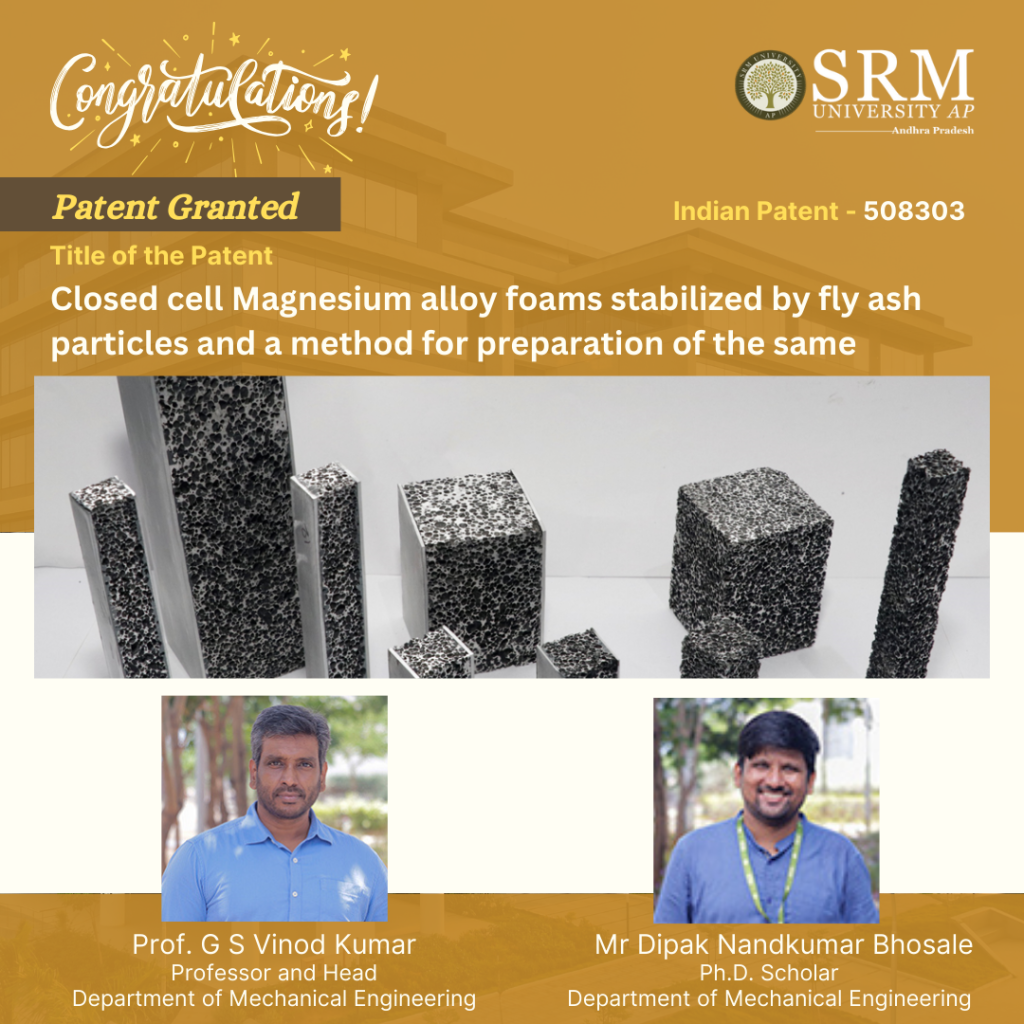
In the era of scientific advancement, Prof. G S Vinod Kumar, HoD and his Research Scholar, Dipak Nandkumar Bhosale, from the Department of Mechanical Engineering at SRM University-AP, shine as a beacon of inspiration. The teacher-student duo were granted a patent for their research titled “Closed Cell Magnesium Alloy Foams Stabilized by Fly Ash Particles and A Method for Preparation for the Same.” This patent stands as a testament to their relentless pursuit and unwavering commitment to science.
Kudos to Prof. G S Vinod Kumar and Mr Dipak Nandkumar Bhosale for their exemplary dedication and foresight. Here’s an abstract of their patent-winning research.
Abstract:
A magnesium metal foam product enhanced with fly ash particles demonstrates versatility across multiple applications, including space, automotive, civil engineering, and marine uses. The stability of this magnesium alloy foam is attributed to the incorporation of fly ash particles, particularly alumina silicate (Al2SiO5) cenospheres. These cenospheres, hollow spheres derived from fly ash, serve as effective stabilisers for the magnesium alloy foam. The preparation involves reinforcing magnesium foamable precursors with fly ash particles, facilitating optimal foaming. The presence of fly ash particles ensures the stability of the liquid foam until solidification, resulting in a foam with a superior pore structure. With a contact angle ranging between 70° to 90°, the particles exhibit prolonged interaction with the liquid metal without agglomeration, dissolution, or reaction. This characteristic contributes to the attainment of desirable qualities essential for diverse applications.
Practical Application:
1. Aerospace: Magnesium foams can be used in lightweight structural components, thermal insulation, and vibration-damping systems in aerospace applications.
2. Automotive: In the automotive industry, magnesium foams find applications in lightweight body panels, crash absorbers, and acoustic insulation.
3. Biomedical: Due to their biocompatibility, magnesium foams are utilised in medical implants, such as bone fixation plates, and as scaffolds for tissue engineering.
4. Energy: These foams can be employed in thermal management systems, heat exchangers, and as structural components in renewable energy systems.
5. Sports and Leisure: Magnesium foams can be used in sports equipment such as helmets, pads, and protective gear due to their lightweight and impact-absorbing properties.
Patent Grant Number: 50830
- Published in Departmental News, Mechanical Engineering NEWS, News, Research News
SRM AP and TITAN COMPANY LIMITED Jointly Filed an Industrial Patent
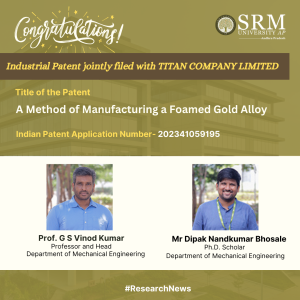 SRM University-AP and TITAN COMPANY LIMITED, a leading jewellery brand in India, have collaborated to engineer novel jewellery products using advanced materials and technologies. The joint research project, led by HOD Prof. G S Vinod Kumar and Ph.D. Scholar Dipak Nandkumar Bhosale, Department of Mechanical Engineering, has resulted in a new method of manufacturing foamed gold alloy that is lighter, stronger, and more durable than conventional gold jewellery.
SRM University-AP and TITAN COMPANY LIMITED, a leading jewellery brand in India, have collaborated to engineer novel jewellery products using advanced materials and technologies. The joint research project, led by HOD Prof. G S Vinod Kumar and Ph.D. Scholar Dipak Nandkumar Bhosale, Department of Mechanical Engineering, has resulted in a new method of manufacturing foamed gold alloy that is lighter, stronger, and more durable than conventional gold jewellery.
A joint patent between SRM University-AP and TITAN COMPANY LIMITED has been filed for this innovative method of manufacturing foamed gold alloys. The jewellery products made from this material are currently available in TITAN showrooms under the brand name TANISHQ. The customers can enjoy the benefits of wearing lightweight and high-strength jewellery, which also has a high aesthetic appeal and value.
The collaboration between SRM University-AP and TITAN COMPANY LIMITED exemplifies how academia and industry can work together to create novel and useful products for society. The joint research project also provides an opportunity for the students and faculty of SRM University-AP to gain exposure and experience in the field of jewellery engineering and design and to contribute to advancing science and technology.
Abstract
The current innovation introduces a method for producing foamed gold alloy utilising a liquid metallurgical approach. Gas-releasing agents such as hydrides and carbonates are employed in the manufacturing process. Both 18K and 22K alloys are subjected to foaming in this invention. The resulting foams are stabilised by oxides generated in-situ as well as oxides added externally. These foamed gold alloys exhibit ultra-lower density. The foaming process is successfully executed using both interrupted and uninterrupted methods. These foamed gold alloys find applications in various fields including Jewellery and medical implants.
The title of patent in the citation format
“G. S. Vinod Kumar, Dipak Nandkumar Bhosale. A METHOD OF MANUFACTURING A FOAMED GOLD ALLOY. Indian Patent application number 202341059195 filed Sep 04, 2023”
Patent Application number
202341059195
Inventors
1. G. S. Vinod Kumar 2. Dipak Nandkumar Bhosale
- Published in Departmental News, Mechanical Engineering NEWS, News, Research News
From Vision to Reality: Assessing the Feasibility of One Nation, One Election in India
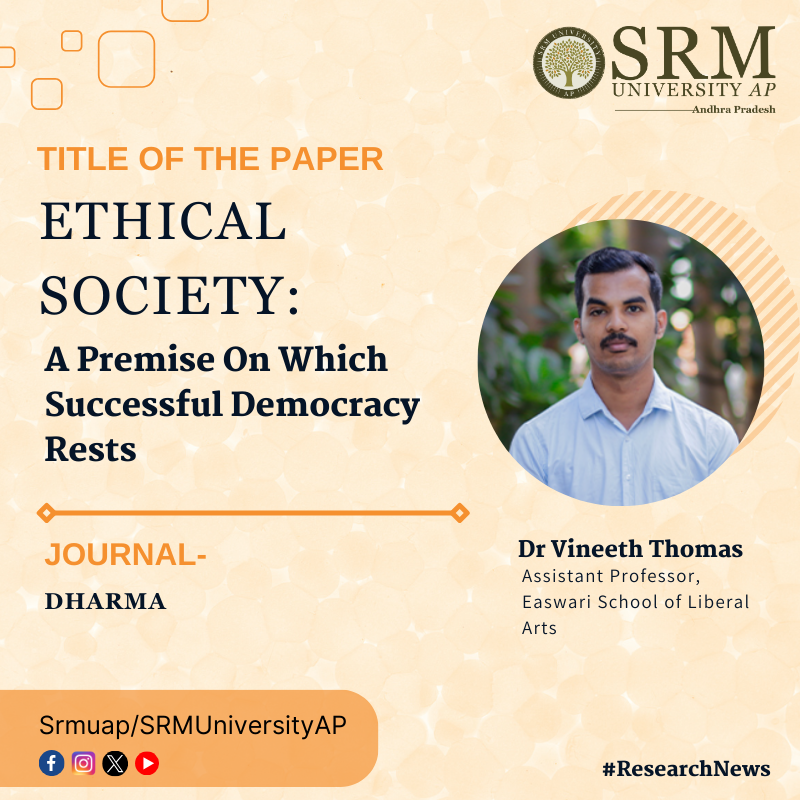
In the grand spectacle of democracy, every ballot cast represents a pivotal moment in shaping the collective destiny of a nation. However, what happens when the destiny of 1.4 billion people lacks a solid foundation of values and ethics?
Dr Vineeth Thomas, Assistant Professor at the Department of Liberal Arts, in his research paper titled “Ethical Society: A Premise On Which Successful Democracy Rests”, delves into these complexities of democratic regression that threaten to shake the foundations of our political system.
ABSTRACT:
Samuel Phillips Huntington’s thesis on the ‘Third Wave’ of democratisation, as presented in his seminal work “The Third Wave: Democratization in the Late Twentieth Century”, posited democracy as the preeminent and widely accepted form of governance. While democracy may prevail quantitatively in contemporary times, it grapples with numerous challenges in terms of its qualitative aspects. This research article identifies the absence or dearth of ethical values as a significant factor contributing to the erosion of democracies worldwide. Moreover, this erosion has the potential to incite a ‘new wave against democracy’. Consequently, this article aims to explore the potential remedy for this issue by anchoring democracy in an ethically conscious society. We contend that an ethically grounded society serves as a fundamental prerequisite for nurturing a high-quality and prosperous democracy, ultimately acting as a formidable barrier against the imminent and looming threats to democratic systems.
The link to the article
- Published in Departmental News, Liberal Arts News, News, Research News
Rethinking Ionic Liquids as an Environment-friendly Solvent
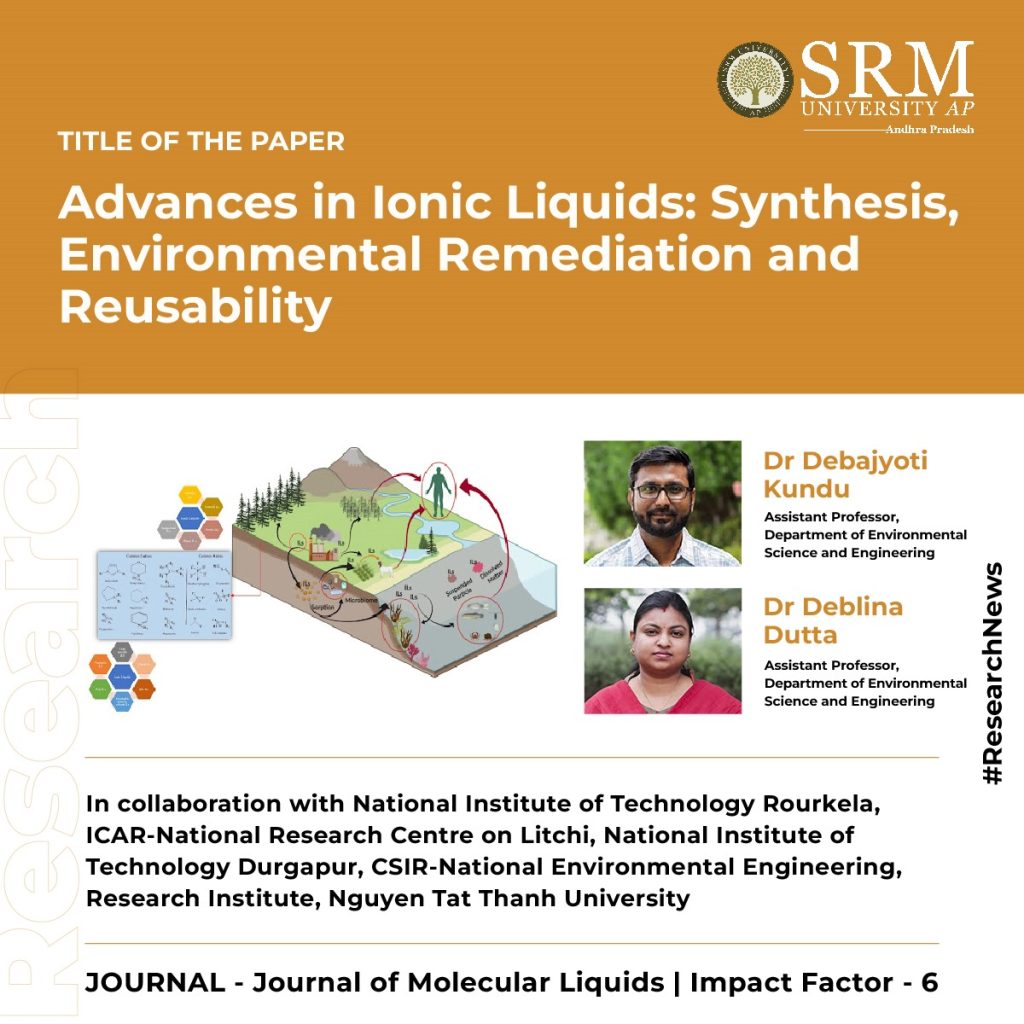
Dr Debajyoti Kundu and Dr Deblina Dutta, Assistant Professors, Department of Environmental Science and Engineering, have conducted seminal research on Ionic Liquids (ILs) in their paper “Advances in ionic liquids: Synthesis, environmental remediation and reusability” published in the Q1 journal, Journal of Molecular Liquids with an impact factor of 6. In the research article, the faculty duo have delved into the unique properties of ionic liquids, focusing on their role in environmental cleanup and showcasing their ability to combat pollutants. Various methods to recycle and reuse ILs, develop eco-friendly ILs, and scale up their application for effective environmental remediation have also been extensively explored.
Abstract
Ionic liquids (ILs) are next-generation solvents synthesised by organic salts, possessing negligible vapour pressure and low flammability. They possess high thermal and electrochemical stability, can be reused for multiple cycles, and their properties can be tuned according to the components used in their synthesis. Hence, ILs are considered to be potential alternatives for conventional organic solvents for numerous applications such as environmental remediation, nanoparticle synthesis, catalysts in various chemical reactions, solvents for the extraction of biomolecules from recalcitrant lignocellulosic biomass, etc. In this review article, the holistic approach of ILs, starting from various techniques adopted for their synthesis along with its critical review, is discussed, followed by a detailed discussion of the mechanism involved in the remediation of environmental pollutants using ILs. Further, in-depth documentation of various environmental pollutants remediated using ILs has been done to date. One of the major drawbacks of solvent application is the reusability factor, and hence, in this review article, techniques adopted to recycle/reuse ILs have been discussed. Further, the adverse effects of using ILs for environmental remediation have been comprehensively discussed to present a holistic view. Future studies should focus on synthesising environment-friendly ILs and their field-scale applications for environmental remediation.
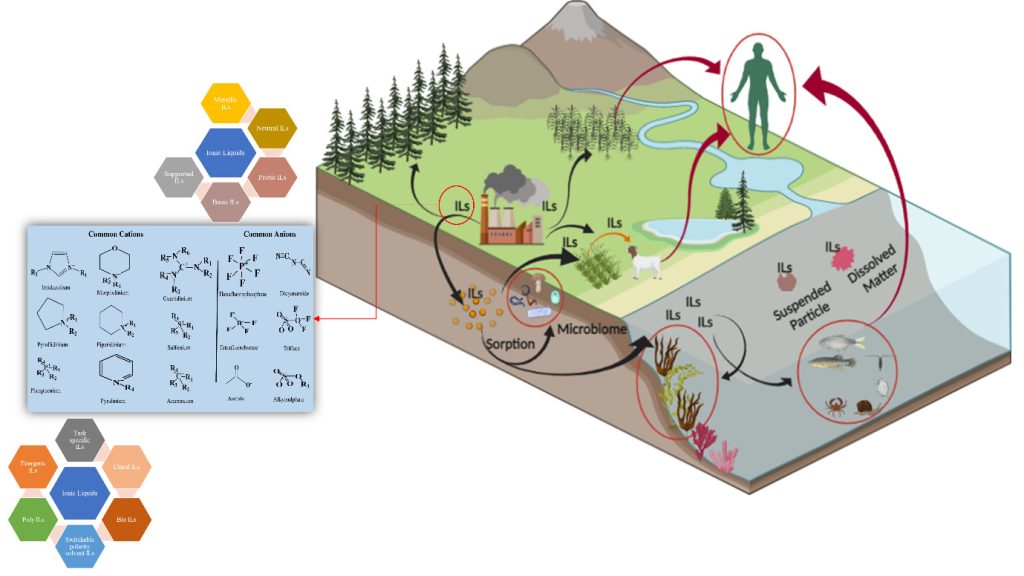
Practical implementation/social implications of the research
Their research on Ionic Liquids (ILs) presents a transformative approach to environmental challenges. By applying ILs on a larger scale for cleaning polluted air and water, promoting recycling and reusability, and developing eco-friendly ILs, the work has direct implications for industries and communities. The adoption of IL-based technologies contributes to efficient environmental cleanup and aligns with the growing societal demand for sustainable practices. Successful field-scale applications and public awareness initiatives can lead to a cleaner and healthier environment, demonstrating the tangible benefits of incorporating ILs into real-world solutions and fostering a more responsible and eco-conscious society.
Collaborations:-
- National Institute of Technology Rourkela
- ICAR-National Research Centre on Litchi
- National Institute of Technology Durgapur
- CSIR-National Environmental Engineering Research Institute
- Nguyen Tat Thanh University
Dr Kundu and Dr Dutta remarks that their future research in the realm of Ionic Liquids (ILs) will prioritise the development of environmentally sustainable synthesis methods, rigorous assessments of biodegradability and toxicity, and integrating ILs into industrial processes. Scaling up studies to evaluate their effectiveness in large-scale environmental remediation, investigating public perceptions, and fostering multidisciplinary collaborations with experts from diverse fields will be crucial for the responsible adoption of IL-based technologies. Additionally, focusing on life cycle assessments, exploration of novel applications, policy recommendations, and educational outreach can collectively contribute to advancing the understanding and practical implementation of ILs, ensuring a holistic and impactful approach to their environmental applications.
Click to read the article!
- Published in Departmental News, ENVS News, News, Research News

